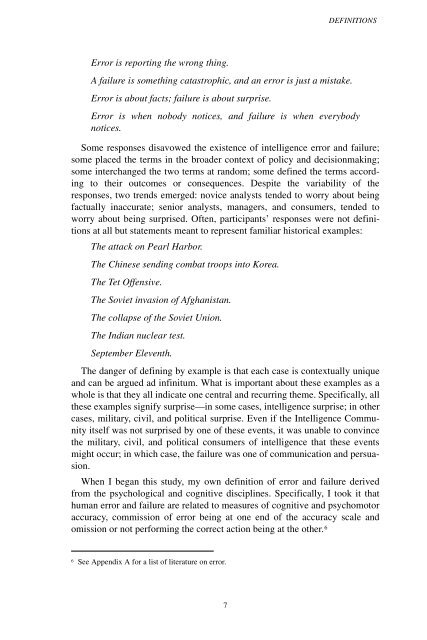Analytic Culture in the U.S. Intelligence Community (PDF) - CIA
Analytic Culture in the U.S. Intelligence Community (PDF) - CIA
Analytic Culture in the U.S. Intelligence Community (PDF) - CIA
You also want an ePaper? Increase the reach of your titles
YUMPU automatically turns print PDFs into web optimized ePapers that Google loves.
DEFINITIONS<br />
Error is report<strong>in</strong>g <strong>the</strong> wrong th<strong>in</strong>g.<br />
A failure is someth<strong>in</strong>g catastrophic, and an error is just a mistake.<br />
Error is about facts; failure is about surprise.<br />
Error is when nobody notices, and failure is when everybody<br />
notices.<br />
Some responses disavowed <strong>the</strong> existence of <strong>in</strong>telligence error and failure;<br />
some placed <strong>the</strong> terms <strong>in</strong> <strong>the</strong> broader context of policy and decisionmak<strong>in</strong>g;<br />
some <strong>in</strong>terchanged <strong>the</strong> two terms at random; some def<strong>in</strong>ed <strong>the</strong> terms accord<strong>in</strong>g<br />
to <strong>the</strong>ir outcomes or consequences. Despite <strong>the</strong> variability of <strong>the</strong><br />
responses, two trends emerged: novice analysts tended to worry about be<strong>in</strong>g<br />
factually <strong>in</strong>accurate; senior analysts, managers, and consumers, tended to<br />
worry about be<strong>in</strong>g surprised. Often, participants’ responses were not def<strong>in</strong>itions<br />
at all but statements meant to represent familiar historical examples:<br />
The attack on Pearl Harbor.<br />
The Ch<strong>in</strong>ese send<strong>in</strong>g combat troops <strong>in</strong>to Korea.<br />
The Tet Offensive.<br />
The Soviet <strong>in</strong>vasion of Afghanistan.<br />
The collapse of <strong>the</strong> Soviet Union.<br />
The Indian nuclear test.<br />
September Eleventh.<br />
The danger of def<strong>in</strong><strong>in</strong>g by example is that each case is contextually unique<br />
and can be argued ad <strong>in</strong>f<strong>in</strong>itum. What is important about <strong>the</strong>se examples as a<br />
whole is that <strong>the</strong>y all <strong>in</strong>dicate one central and recurr<strong>in</strong>g <strong>the</strong>me. Specifically, all<br />
<strong>the</strong>se examples signify surprise—<strong>in</strong> some cases, <strong>in</strong>telligence surprise; <strong>in</strong> o<strong>the</strong>r<br />
cases, military, civil, and political surprise. Even if <strong>the</strong> <strong>Intelligence</strong> <strong>Community</strong><br />
itself was not surprised by one of <strong>the</strong>se events, it was unable to conv<strong>in</strong>ce<br />
<strong>the</strong> military, civil, and political consumers of <strong>in</strong>telligence that <strong>the</strong>se events<br />
might occur; <strong>in</strong> which case, <strong>the</strong> failure was one of communication and persuasion.<br />
When I began this study, my own def<strong>in</strong>ition of error and failure derived<br />
from <strong>the</strong> psychological and cognitive discipl<strong>in</strong>es. Specifically, I took it that<br />
human error and failure are related to measures of cognitive and psychomotor<br />
accuracy, commission of error be<strong>in</strong>g at one end of <strong>the</strong> accuracy scale and<br />
omission or not perform<strong>in</strong>g <strong>the</strong> correct action be<strong>in</strong>g at <strong>the</strong> o<strong>the</strong>r. 6<br />
6<br />
See Appendix A for a list of literature on error.<br />
7
















